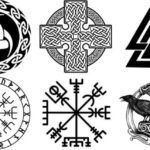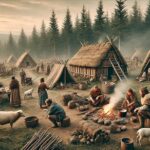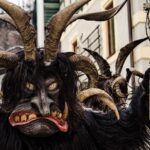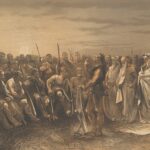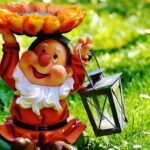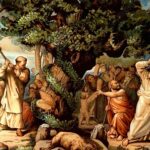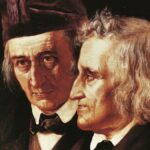
Before Christianity reached the forests and rivers of ancient Germania, the Germanic peoples lived in a world animated by gods, spirits, and sacred forces of nature. Their mythology and religious practices formed a deeply spiritual and symbolic part of their identity. Passed down orally, these beliefs helped explain the mysteries of life and death, guided social norms, and inspired heroic tales that still echo through European culture today.
The Pantheon of Germanic Gods
Germanic mythology featured a diverse pantheon of deities, many of whom would later appear in Norse mythology. The gods were often associated with natural forces, human emotions, and societal functions:
- Odin (Wodan): The chief deity, god of wisdom, magic, war, and death. He sacrificed an eye for knowledge and was associated with ravens and runes.
- Thor (Donar): God of thunder and protection. Armed with his hammer Mjölnir, he defended humanity and the gods from chaos.
- Freya: Goddess of love, fertility, and battle. She was linked with both sensuality and the warrior afterlife.
- Tyr: God of justice and war, known for his sacrifice of a hand to bind the wolf Fenrir.
- Frigg: Odin’s wife, associated with motherhood and foresight.
Other deities included Loki (a trickster), Balder (a god of light), and numerous local gods tied to rivers, forests, and household life.
Creation Myths and Cosmology
Germanic cosmology described a multiverse connected by the World Tree (Yggdrasil). Nine realms existed, including:
- Asgard – home of the gods
- Midgard – the world of humans
- Helheim – realm of the dead
Creation myths told of a primordial void, Ginnungagap, where fire and ice met to form life. The world was shaped from the body of a giant, Ymir, and the cycle of life was governed by fate (Wyrd) and the Norns—female beings who spun the destinies of gods and men.
The end of the world, Ragnarök, was a central myth in which the gods faced a cataclysmic battle, symbolizing the natural cycle of destruction and rebirth.
Sacred Spaces and Ritual Practices
Germanic religious life did not involve temples in the modern sense. Instead, worship occurred in sacred groves, springs, or hilltops. These natural sites were considered holy, and rituals were performed to honor the gods and spirits of the land.
Ritual practices included:
- Animal sacrifices (and sometimes human)
- Feasting and seasonal celebrations
- Burning or burying offerings in water or earth
- Divination using runes or animal entrails
These rites marked important occasions—planting, harvest, victories in battle, or changes in leadership.
Shamans, Seers, and Women in Religion
Spiritual guidance came from individuals believed to have special connections to the divine. Seers (völvas), often women, interpreted omens and guided communities through visions, dreams, and trance-like rituals. Women were particularly respected in religious contexts, acting as priestesses and keepers of sacred lore.
Shamans or spiritual elders often led ceremonies and healing practices. Their role blurred the line between religious, medicinal, and social functions.
Oral Tradition and Mythic Storytelling
Myths and legends were preserved and passed on through oral storytelling, long before they were recorded by later Christian monks in Norse epics like the Poetic Edda or Prose Edda.
Tales often centered on:
- Epic battles between gods and giants
- Quests for magical objects (like Odin’s quest for runes)
- Themes of honor, betrayal, fate, and sacrifice
These stories were performed during feasts and gatherings, reinforcing cultural values and shared memory.
Transition to Christianity
Beginning in the 4th–6th centuries CE, missionaries began converting Germanic tribes to Christianity, often starting with tribal elites. Conversion was gradual, with pagan and Christian elements coexisting for centuries.
As Christianity spread, many pagan sites were Christianized, and old gods demonized or recast as folklore figures. However, many customs—such as Yule (Jul), May Day, and harvest festivals—persisted in Christianized forms.
Legacy and Influence
Germanic mythology laid the groundwork for much of Northern European folklore and fantasy literature. Its influence can be seen in:
- The works of J.R.R. Tolkien
- German and Norse fairy tales
- Modern pagan and neopagan movements
- National symbolism during German Romanticism
Even the names of the days of the week (e.g., Wednesday for Wodan’s Day, Thursday for Thor’s Day) reflect this mythological legacy.
The spiritual world of the Germanic tribes was rich, symbolic, and deeply connected to nature. Their mythology helped explain the world around them, guided community rituals, and inspired epic storytelling. Though many of their beliefs faded under Christian influence, their legacy lives on in our language, culture, and imagination.
To dive deeper into the early spiritual life of these peoples, explore Daily Life of the Germanic Tribes, The Origins of the Germanic Peoples, and Arminius and the Battle of the Teutoburg Forest.
Related articles:
The Most Haunted Places in Germany: Castles, Ghosts, and Legends
How the Black Forest Shaped German Mythology and Culture
The German Witch Hunts: A Dark Chapter in European History
Why Do Germans Love Garden Gnomes? – Discover the cultural roots of Germany’s love for garden gnomes, from folklore to kitsch to national pride.
